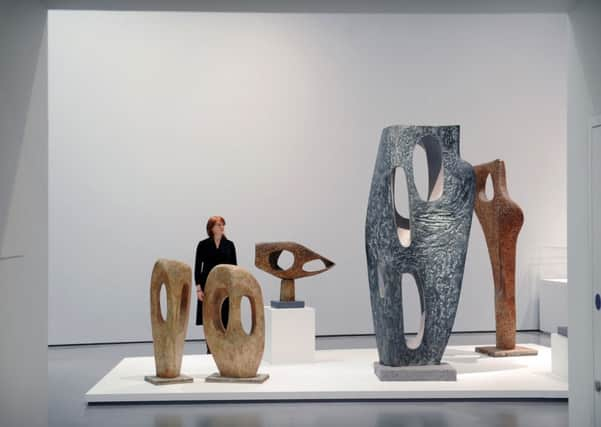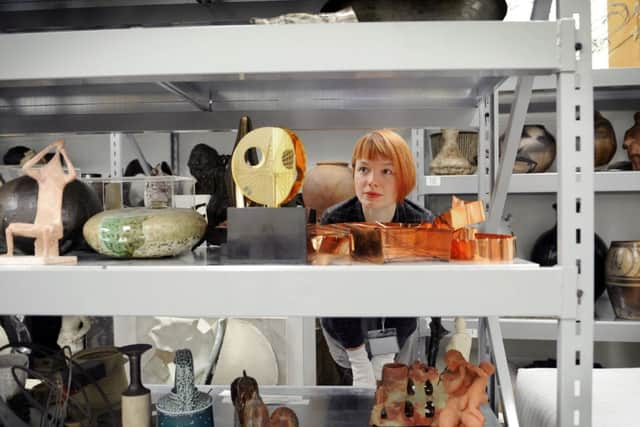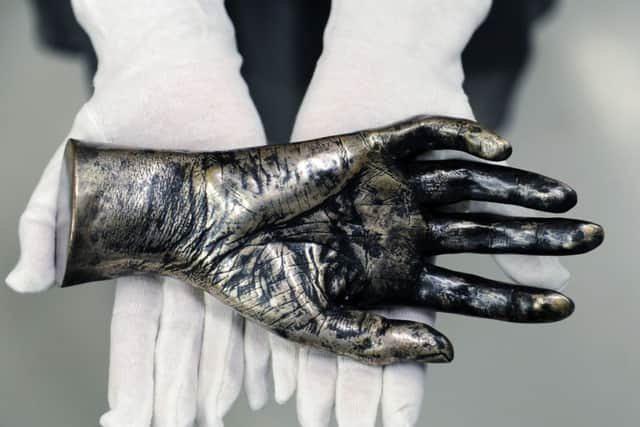Hidden values


‘We don’t normally let people come down here. In fact, I don’t think we’ve ever had anyone in the stores who doesn’t work in the building,” says Frances Guy. “It’s all environmentally controlled – we regulate the temperature and humidity If someone wanted to see a work of art from the stores we would take it out and put it into a room where it can be seen – rather than bringing them down here.”
She’s clearly nervous.
Little wonder. As head of collections at The Hepworth Wakefield, she is responsible for the priceless collection of art languishing in the heavily fortified stores of the county’s newest purpose-built gallery. Giving the Yorkshire Post exclusive access to the stores has not happened overnight.
Advertisement
Hide AdAdvertisement
Hide Ad

It is, however, an important thing to do – to allow us in to share the story.
In a time of austerity, there are big questions being asked about the stores of great art kept by our public galleries and authorities. In November last year a Liberal Democrat and a Conservative councillor on Bradford Council called for the city to sell off its artworks.
The council’s collection, it transpired, had been massively undervalued and might in fact be worth close to £600m than the £30m value it had previously been given. The council’s Lib Dem leader Councillor Jeanette Sunderland and Tory leader Coun Glen Miller called for the collection to be sold. Coun Miller said: “I am sure they were purchased with taxpayers’ money so maybe we could use this to offset the huge tax increases and cuts to services that this Labour-led authority is doing.”
David Hockney issued a terse statement which said that was the council to sell off its art, including his works, he would seriously consider “giving up on the city”. Ultimately the fire sale was called off – at least for the time being – but before the sale was ruled out, Simon Wallis, director of The Hepworth Wakefield, was also throwing his hands up in despair alongside Hockney.
Advertisement
Hide AdAdvertisement
Hide Ad

“These collections are absolutely irreplaceable,” says Wallis, who talks with serious passion when a subject gets him going. As the head of the gallery, he is the man who oversees a collection of art that includes many priceless works and many by the eponymous sculptor. “There is no question that private individuals would come in, hoover them up and they would not be seen again in the public realm. Or certainly not easily – they might well be bought by private individuals in places like Qatar – I don’t want to have to go to Qatar to see a Hepworth.”
Okay, so Wallis doesn’t want to jump on a plane to see the work that was hewn in Yorkshire by its most famous artist daughter. Does that mean it is definitely the right thing not to sell off at least some of the collection? Surely when not a week goes by without more news of further cuts to arts funding, sitting on a collection worth several million is a little hard to justify?
“Absolutely not. The moral underpinning is that these collections are held in trust for us by future generations. We sell it, we will never get it back – there is only one way the prices are going for these works, so decade on decade you would get to a stage where you would never be able to replace them.”
The Wakefield Art Collection has been built over almost 100 years, with the city’s curators adding to the collection over the past century. There are 5,000 works of art, the Hepworth family gift, the rarely seen Gott collection and much, much more.
Advertisement
Hide AdAdvertisement
Hide AdAs head of collections at The Hepworth Wakefield, Frances Guy is carrying on that tradition. When she leads me and a photographer through the bowels of the beast that is the brutalist Sir David Chipperfield-designed building, towards the stores, there is a sense that she is enjoying showing off. Well she might.
“It’s a huge source of civic pride. There are people in Wakefield who have literally grown up with this collection – some of them have become Friends of The Hepworth and so they stay involved,” she says. “I’ve just been on a research trip to Strasbourg, the home of Jean Arp, and the sense of pride is really palpable. The fact that this major figure of European avant garde was born in the city and the city retains a collection of his work in a wonderful museum is something that gives the people of the city enormous pride. You see children going through the museums, learning about him – and that’s what we’re doing here. There simply wouldn’t be a question of the museum selling off its collection of his work. Why should we raise those questions in this country?”
It’s difficult when playing devil’s advocate to not simply keep saying “yes, but”. The question will raise its head again, but for now it does seem worth pausing to take in the fact that last month the New York Times was praising our beautiful corner of England stating that we are “on the international cultural map”. Wallis brings up the article, which was based on the success of the Yorkshire Sculpture Triangle, the collective name invented for the Yorkshire Sculpture Park, The Hepworth Wakefield, The Henry Moore Institute and Leeds Art Gallery, to demonstrate the power of art.
“Can you imagine what it would have cost to get that kind of coverage if you were paying for it as an advert? In a modern world where we are saturated by media, coverage like that is exceptional,” says Wallis. While it’s all but impossible to quantify, how’s this for cause and effect: the fact is that some will read the New York Times, will be inspired to put Yorkshire on the list of places they must visit, will come here and will spend a lot of money. They will come because the New York Times wrote about us, they wrote about us because of the Yorkshire Sculpture Triangle, the Yorkshire Sculpture Triangle exists because of the addition to the county’s cultural scene of The Hepworth, the Hepworth exists thanks to local council and Arts Council funding.
Here’s the last piece of the jigsaw.
Advertisement
Hide AdAdvertisement
Hide Ad“Without the collection, The Hepworth wouldn’t exist,” says Wallis, unequivocal.
It’s an easy argument to make. The collection needs somewhere to be – the Hepworth becomes that place.
“The collection is the reason for The Hepworth to be here – without it, there just wouldn’t be a need for such a facility. But let’s say The Hepworth did exist already – do we need a collection then? Without the collection you can say goodbye to your relationship to the Tate, to The British Museum, to the V&A. We borrow from those collections, but it is a quid pro quo. Once you get a reputation for selling work, you get a reputation for short-termism, artists and collectors won’t bequeath work to you. The reason we get high level loans in from the Tate and the British Museum or the Duke of Devonshire as we have now, or private collectors, is because of the quality of collection that is here. It’s an extra bit of leverage to make sure there is this public access to a wide range of work that either would remain in private hands or work that would reside in London as was the case before this was built.”
So to the collection. The first Wakefield Art Gallery opened in Wentworth Terrace in 1934. The first curator was Ernest Musgrave and he was followed by Eric Westbrook and Helen Kapp. Their ambitions are the reason the collection began, and grew and now has the security of a bunker in a new building to protect it.
Advertisement
Hide AdAdvertisement
Hide AdFrances Guy says: “Ernest Musgrave’s intention was that the collection should grow and reflect contemporary life, by buying the work of modern artists. When the collection was in its infancy the gallery and the museum had a space in the park. Philanthropists donated to the collection, the Art Fund has helped over the years, the Contemporary Art Society, they have all been instrumental in building up this collection. There have been many people and organisations that have helped because of the principle that a growing collection contributes to people’s knowledge and their sense of a place in the world.”
There is one other issue. The Hepworth is a genuinely magnificent space. The building’s decriers remain – but naysayers used the local media to take Ernest Musgrave to task. Now, everyone can, surely, with the benefit of time, realise that Musgrave has enriched the lives of future generations. The problem is that no matter how magnificent, it will never be big enough to show everything it stores.
Tomorrow sees the end of the London Art Fair, a significant week for the gallery and a solution to this. For the first time, The Hepworth has worked with the Fair to display some wares and show the international art world that while exhibited works might look good, those from storage is equally impressive.
The internationally renowned fair saw The Hepworth show off works from the stores in an exhibition called Barbara Hepworth and the Development of British Modernism.
Advertisement
Hide AdAdvertisement
Hide AdAmong other stored works, The Hepworth was represented by an early sculpture called Kneeling Figure, created in 1934 plus drawings Hepworth’s second husband Ben Nicholson, Henry Moore Terry Frost, Patrick Heron and John Wells.
The gallery is currently working on a digital project that will show stored works online. A development fund to pay for future additions is planned too.
A collection we’d be mad to let go. Even if you can’t always see all of it, it’s good to know it’s there.